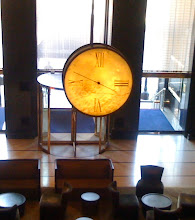
The first full-sky image from the European Space Agency (ESA) Planck telescope has been released, and "It's a spectacular picture; it's a thing of beauty," Dr Jan Tauber, the European Space Agency's (Esa) Planck project scientist, told
BBC News.
Planck, launched in May 2009, occupies an observing position more than one million km from Earth on its "night side." (Technically, Planck's operational orbit is around the second Lagrange point of the Sun-Earth system, L2.)
The detectors of Planck's High Frequency Instrument have an operational temperature of -273.05°C, only 0.1°C above absolute zero - the coldest temperature theoretically possible in our Universe. Such low temperatures are necessary for Planck’s detectors to study the Cosmic Microwave Background (CMB), the first light released by the universe only 380 000 yrs after the Big Bang, by measuring its temperature across the sky. Specifically, Planck will look for evidence of "inflation," the faster-than-light expansion that cosmologists believe the Universe experienced in its first, fleeting moments. Theory predicts this event ought to be "imprinted" in the CMB and its detail should be retrievable with sufficiently sensitive instruments.
For more information on the Planck mission, visit the
ESA - Planck Web site.
For something extra cool, visit the
Chromoscope site, which lets you explore our Galaxy (the Milky Way) and the distant Universe in a range of wavelengths from X-rays to the longest radio waves.
Update (2010-07-09) Uncovered
this article (PDF, subscription required) in
Science describing the Planck mission. Planck is the third to study the CMB, following the earlier COBE (1992) and WMAP (2003) satellites. From the
Science article:
Planck will chart the temperature variations in CMB with 10 times WMAP's sensitivity and three times its angular resolution. The microwaves are also polarized so that the electric fields in waves coming from any particular spot in the sky wiggle in a definite direction—just as ordinary light waves reflected from a pond are polarized so they oscillate horizontally as they zip into your eye. WMAP sketched the polarization of the CMB; Planck will render it in great detail.
Planck will be far more sophisticated than its predecessors. WMAP sampled microwaves at five frequencies; Planck will monitor nine of them over a range 12 times wider. WMAP cooled its detectors by exposing them to the frigidity of space; some of Planck's detectors must be cooled to within a fraction of a degree of absolute zero with a liquid-helium refrigerator. As WMAP did, Planck will circle the sun in synchrony with Earth, hovering at the so-called second Lagrange point, or L2 .
. . .
But the prize quarry for Planck researchers is the B modes. These features are swirls in the CMB polarization mapped across the sky, and spotting them would essentially clinch the case for the mind-bending theory of inflation.
The notion that the universe briefly expanded at faster than light speed might seem absurd, but it solves some thorny problems in cosmology, including a big one posed by the CMB itself. The temperature of background radiation is almost exactly the same—2.725 kelvin—all over the sky. That's perplexing because the distant reaches of the universe in opposite directions are so far apart that not even light has had time to travel between them. So they could not have interacted and should have no reason to have reached so nearly the same temperature. Inflation solves this problem by positing that opposite ends of the universe were cheek-by-jowl until the sudden expansion pulled them very far apart.
Although inflation fits the facts so far, researchers do not yet have direct proof that it occurred. The B modes would provide that. Current theory predicts that inflation should have generated gravitational waves and that those waves should have left lingering swirls in the polarization of the CMB.

